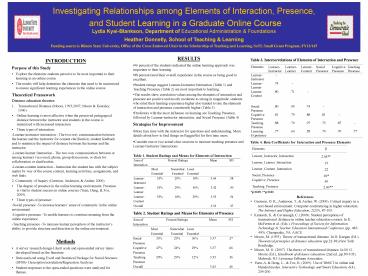Investigating Relationships among Elements of Interaction, Presence, - PowerPoint PPT Presentation
Title:
Investigating Relationships among Elements of Interaction, Presence,
Description:
Investigating Relationships among Elements of Interaction, Presence, and Student Learning in a Graduate Online Course Lydia Kyei-Blankson, Department of Educational ... – PowerPoint PPT presentation
Number of Views:48
Avg rating:3.0/5.0
Title: Investigating Relationships among Elements of Interaction, Presence,
1
Investigating Relationships among Elements of
Interaction, Presence, and Student Learning in a
Graduate Online Course Lydia Kyei-Blankson,
Department of Educational Administration
Foundations Heather Donnelly, School of Teaching
Learning Funding source is Illinois State
University, Office of the Cross Endowed Chair in
the Scholarship of Teaching and Learning, SoTL
Small Grant Program, FY13/145
- RESULTS
- 96 percent of the students indicated the online
learning approach was important to their learning - 88 percent rated their overall experience in the
course as being good to excellent. - Student ratings suggest Learner-Instructor
Interaction (Table 1) and Teaching Presence
(Table 2) are most important to learning. - The results show correlation values among the
elements of interaction and presence are positive
and mostly moderate to strong in magnitude
students who rated their learning experience
higher also tended to rate the elements of
interaction and presence consistently higher
(Table 3) - Predictors with the most influence on learning
are Teaching Presence, followed by
Learner-instructor interaction, and Social
Presence (Table 4) - Strategies for Improvement
- More face time with the instructor for questions
and understanding. More details about how to find
things on ReggieNet for first time users. - Consider one or two actual class sessions to
increase teaching presence and Learner-Instructor
Interactions - Table 1. Student Ratings and Means for Elements
of Interaction
- Table 3. Intercorrelations of Elements of
Interaction and Presence - Table 4. Beta Coefficients for Interaction and
Presence Elements
- INTRODUCTION
- Purpose of this Study
- Explore the elements students perceive to be most
important to their learning in an online course - The results will help determine the elements that
need to be maximized to ensure significant
learning experiences in the online course. - Theoretical Framework
- Distance education theories
- Transactional Distance (Moore, 19932007 Moore
Kearsley, 1996) - Online learning is most effective when the
perceived pedagogical distance between the
instructor and students in the course is
minimized with increased interaction - Three types of interaction
- -Learner-instructor interaction - The two-way
communication between the learner and the
instructor for content clarification, student
feedback and to minimize the impact of distance
between the learner and the instructor. - -Learner-learner Interaction - The two-way
communication between or among learners via
e-mail, phone, group discussions, or chats for
collaboration or clarification. - -Learner-content interaction - Interaction the
student has with the subject matter by way of the
course content, learning activities, assignments,
and web links. - 2. Community of Inquiry (Garrison, Anderson,
Archer, 2000). - The degree of presence in the online learning
environment. Presence is vital to student success
in online courses (Yuen, Deng, Fox, 2009). - Three types of presence
- -Social presence -To increase learners sense of
community in the online environment - -Cognitive presence -To enable learners to
construct meaning from the online experience - -Teaching presence -To increase learner
perception of the instructors ability to provide
structure and direction in the online environment
Elements Learner-Instructor Learner-Learner Learner-Content Social Presence Cognitive Presence Teaching Presence
Learner-Instructor -
Learner-Learner .74 -
Learner-Content .80 .71 -
Social Presence .80 .90 .74 -
Cognitive Presence .81 .79 .88 .81 -
Teaching Presence .88 .70 .97 .75 .87 -
Learning Experience .77 .64 .58 .70 .70 .77
Elements ß
Learner_Instructor_Interaction 2.04
Learner_Learner_Interaction .19
Learner_Content_Interaction .22
Social_Presence .69
Cognitive_Presence .49
Teaching_Presence 2.06
Area of Interaction Percent Ratings Percent Ratings Percent Ratings Mean SD
Most Essential Somewhat Essential Least Essential
Learner-Instructor 53 29 18 3.64 .58
Learner-Learner 35 29 36 3.42 .50
Learner-Content 53 18 29 3.53 .54
Overall 3.53 .37
Area of Interaction Percent Ratings Percent Ratings Percent Ratings Mean SD
Most Essential Somewhat Essential Least Essential
Social Presence 35 29 36 3.37 .57
Cognitive Presence 47 24 29 3.37 .66
Teaching Presence 59 29 12 3.55 .56
Overall 3.45 .46































